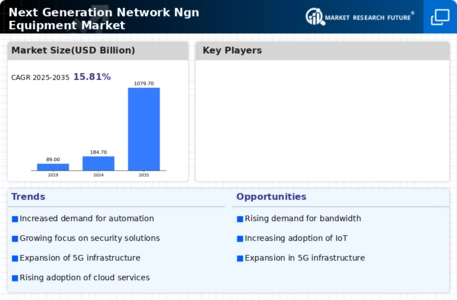Expansion of 5G Networks
The rollout of 5G networks is a pivotal driver for the Global Next Generation Network NGN Equipment Market Industry. As countries worldwide prioritize the deployment of 5G technology, the demand for NGN equipment is expected to escalate. This transition not only enhances mobile broadband services but also facilitates the development of smart cities and autonomous vehicles. The market is likely to witness substantial growth, with projections indicating a potential market size of 1079.7 USD Billion by 2035. The integration of 5G technology into existing infrastructures necessitates significant investments in NGN equipment, thereby propelling market expansion.
Market Growth Projections
The Global Next Generation Network NGN Equipment Market Industry is poised for remarkable growth, with projections indicating a market size of 184.7 USD Billion in 2024 and an anticipated increase to 1079.7 USD Billion by 2035. This growth trajectory reflects a robust CAGR of 17.41% from 2025 to 2035, driven by factors such as the expansion of 5G networks, increased cloud adoption, and government investments in digital infrastructure. The market dynamics suggest a favorable environment for innovation and technological advancements, positioning NGN equipment as a cornerstone of future telecommunications.
Emergence of Smart Technologies
The emergence of smart technologies is driving transformation within the Global Next Generation Network NGN Equipment Market Industry. Innovations such as artificial intelligence, machine learning, and the Internet of Things are reshaping how networks operate and are managed. These technologies require sophisticated NGN equipment capable of handling vast amounts of data and providing real-time analytics. As industries adopt smart solutions for automation and efficiency, the demand for advanced network infrastructure is expected to rise. This trend underscores the necessity for telecom operators to invest in NGN equipment to remain competitive in a rapidly evolving digital landscape.
Increased Adoption of Cloud Services
The growing adoption of cloud services is significantly influencing the Global Next Generation Network NGN Equipment Market Industry. Organizations are increasingly migrating to cloud-based solutions to enhance operational efficiency and scalability. This shift necessitates the deployment of advanced NGN equipment to ensure seamless connectivity and data transfer. As businesses transition to hybrid and multi-cloud environments, the demand for reliable and high-performance network infrastructure intensifies. The market is projected to grow at a CAGR of 17.41% from 2025 to 2035, reflecting the critical role of NGN equipment in supporting cloud service delivery.
Government Initiatives and Investments
Government initiatives aimed at enhancing digital infrastructure are playing a crucial role in the Global Next Generation Network NGN Equipment Market Industry. Many countries are investing in broadband expansion projects to bridge the digital divide and promote economic growth. These initiatives often include funding for the deployment of NGN equipment, which is essential for modernizing telecommunications networks. By fostering public-private partnerships, governments are creating an environment conducive to innovation and investment in NGN technologies. This proactive approach is likely to stimulate market growth and improve connectivity across urban and rural areas.
Rising Demand for High-Speed Connectivity
The Global Next Generation Network NGN Equipment Market Industry is experiencing a surge in demand for high-speed connectivity, driven by the increasing reliance on digital services. As businesses and consumers seek faster internet access, the market is projected to reach 184.7 USD Billion in 2024. This demand is fueled by the proliferation of cloud computing, IoT devices, and streaming services, which require robust network infrastructure. The need for enhanced bandwidth and reduced latency is prompting telecom operators to invest in advanced NGN equipment, thereby transforming the landscape of global telecommunications.










